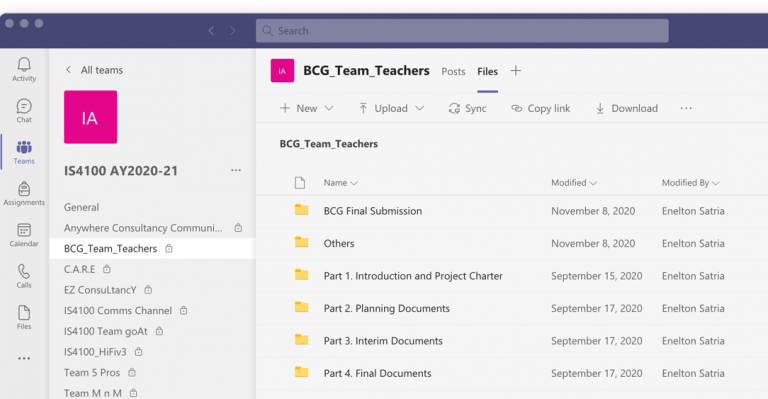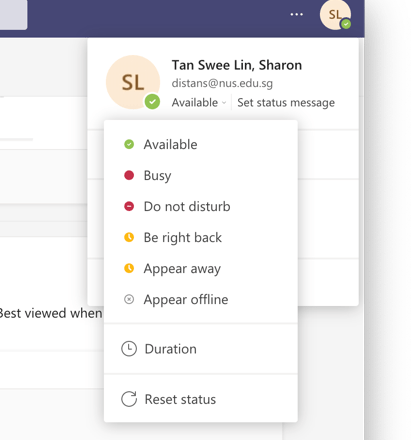Sharon TAN Swee Lin
Department of Information Systems and Analytics, School of Computing (SOC)
Sharon shares her experience of using MS Teams to manage the project teams in her modules, including the challenges encountered and how the process enhanced her students’ learning experiences in these project teams.

Tan, S. S. L. (2021, Oct 29). Using MS Teams for semester-long team-based projects. Teaching Connections https://blog.nus.edu.sg/teachingconnections/2021/10/29/using-ms-teams-for-semester-long-team-based-projects/
Introduction
Features in MS Teams: What We Used and How It Enhanced Students’ Learning
I used the following features in MS Teams: (1) CHANNEL POSTS (2) FILES (3) MS STREAM
| MS Teams Feature | How We Used It | How it Enhanced Students’ Learning Experience |
|---|---|---|
| Channel Posts |
Members in the channel can post messages to each other Serves as a discussion platform for channel members (e.g. clarify course concepts or project requirements), setting up project consultations (e.g. scheduling consultations and sending Zoom meeting links), posting updates (e.g. informing students/instructors of new project documents or updates) (See Figure 2) |
Provides an informal instant messaging platform for students to seek clarifications from the instructor. Messages can be shorter and less formal compared to emails. All project conversations are archived as posts in the team channel, which are arranged by conversation thread, making it easy to track all discussions/messages made between the team and the instructor. It also makes it easy to keep track of unaddressed posts. Emoticons can be used here to show appreciation and acknowledgement to senders that their messages have been received. |

| MS Teams Feature | How We Used It | How it Enhanced Students’ Learning Experience |
|---|---|---|
| Files |
Teams can submit project deliverables, share files or project artefacts to get instructor feedback. Feedback can be provided directly within the shared files (e.g. adding comments within the word documents) TA and instructors can also share any notes or additional feedback documents via a file upload. Students can collaborate on writing and editing documents. This feature was extended to facilitate online lectures where students would collaborate to generate questions for guest speakers or share key points from their group discussions. |
Having a shared file space makes it easier for students and instructor to find all project-related documents/artefacts. Students have greater control over organisation of files (e.g. organising them into meaningful file folders) to facilitate easy retrieval (see Figure 3). There is less file size restrictions in Teams, making it easier for students to submit their video clips or media files. Instructor’s comments within submitted documents can be viewed by the entire team. Students and instructor can easily follow up on these comments/responses by typing on the document directly, instead of emailing documents back and forth. Enhances student engagement and interaction during online lectures. |

| MS Teams Feature | How We Used It | How it Enhanced Students’ Learning Experience |
|---|---|---|
| MS Stream |
Enables broadcasting of videos within MS Teams to the class via the class channel. In lieu of in-class presentations (which was challenging in online lectures where students are not co-located), project teams can share their team introductions and project presentation videos with the class (see Figure 4). |
Enhances student engagement and interaction in an online setting. Enables collaborative learning and sharing across project teams.
|

Students also used the MS team meeting feature as this provided them with unlimited time for their team meeting unlike with Zoom which has a limit of 40 minutes.
Feedback and Students’ Experiences
Overall students responded positively to the greater ease and effectiveness of communication and collaboration they experienced via MS Teams. This was evident from the student feedback on the positive aspects of their experience with MS Teams (Figure 5):

However, as MS Teams is not as widely adopted across modules in NUS, a few students found it inconvenient to have to straddle between two systems (MS Teams and the university’s learning management system LumiNUS). Some also shared that it was easy to miss new notifications from MS Teams as they may not check in on the system all the time.
Concluding Reflections
Reflecting on my experience, there is no doubt MS Teams has empowered me as an instructor to oversee and work with the project teams over the course of the semester. As all documents, discussions, feedback are organised around each team, it is much easier to access and review each team’s work, track their progress, and provide timely clarifications, advice, and feedback. I also feel closer to the students as are we able to interact more informally over MS Teams.
However, there are a few areas instructors may find useful to take note when using MS Teams. First, it is important to communicate to students the need to check the application daily and for students to regularly remind their team members of new posts. In the event a response is not obtained after making a post to the team, it may be helpful to check in with students via email.
Second, as with using any new tool, there is a learning curve involved. While the set of features used may not be hard to learn, there are some subtle differences in features (e.g. the chat versus channel post) that would be helpful to know to use the tool more effectively. If you are new to the tool, it would be helpful to refer to the wiki guides on MS Teams provided by the NUS Centre for Instructional Technology (CIT).
Third, as students may post questions or upload materials for feedback at any time of the day, the notifications can be disruptive. In MS Teams, we can mitigate the disruptiveness of such notifications by using the “Status Message” function to show our availability (See Figure 6). This would enable students to gauge the speed of our responses or to time their questions.

 |
Sharon TAN Swee Lin is a Senior Lecturer from the Department of Information Systems and Analytics where she teaches a large class foundation module as well as advanced-level project-based modules on business analytics and IT project management. She has strong interests in exploring pedagogical methods and use of technology to enhance student engagement and learning. Sharon can be reached at distans@nus.edu.sg. |

